First drive: 2018 Ferrari 812 Superfast in Italy
Perhaps it’s a legacy of Enzo himself, but Ferrari has never been one to err on the side of conservatism or modesty. Who else would roll out cars with names like ‘Speciale’, ‘LaFerrari’ and ‘Superfast’? Fortunately, the company has the cojones and know-how to back up the bluster, and whenever it unleashes a car with a superlative appellation, said vehicle never fails to deliver on its promise.
The latest extravagantly named offering is the 812 Superfast, which follows in the wheeltracks of the ferocious F12. Obviously, this means there’s a gargantuan V12 up front, sending power to the rear wheels only – in contrast to the V12 variant of the GTC4 Lusso, which apportions drive to all four hoops.

Although the basic format of the 812 is as per its F12 forerunner, Ferrari execs claim 75% of its parts are new, and among the biggest revisions is the introduction of four-wheel-steer, designed to make it more stable at high speeds and less edgy at the limits of cornering adhesion than the frenetic F12. Also new is electric power steering (the 812 is the first Ferrari to go down this route), which has been integrated with the all-wheel-steer system and latest 5.0 version of the Side Slip Control (SSC) electronic safety net.
Befitting its ‘Superfast’ suffix, the 812 boasts some mind-numbing performance numbers. The big-bore (94x78mm) 6.5-litre V12 thumps out a towering 800 hp at 8,500 rpm and 718 Nm at 7,000 rpm, giving it a healthy edge over the 740 hp/690 Nm F12, which no one ever accused of being a pansy.
The 812’s beefed-up outputs are the result of increasing the V12’s capacity from 6,262cc to 6,496cc and optimising combustion via a high-pressure 350 bar direct injection system and F1-inspired variable-geometry inlet tracts (for sharper response right across the rev range). The V12 is a howling masterpiece that spins to 8,900 rpm, yet still manages to deliver 80% of the peak torque quota from as low as 3,500 rpm.

Kerb weight remains unchanged from the F12 at 1,630 kg, so it’s no surprise the 812 leaps from 0-100 kph in 2.9 seconds (despite putting its power to the ground via solely the rear wheels), yet it’s the 0-200 kph figure of 7.9 seconds – almost a full second quicker than a Lamborghini Aventador S – that’s the real eye-opener.
Provided you have access to a long enough stretch of derestricted road, the Superfast won’t stop accelerating until you hit 340 kph, so not much short of a Bugatti Chiron has longer legs – and the latter needs almost double the power and more than twice the torque to achieve its lofty performance figures.
Stats are all well and good, but it’s the 812 Superfast’s impressive breadth of grand-touring capabilities and pure, unadulterated feel-good factor that stamp it as a car that’s destined to go down in the prancing horse annals as an all-time great.
Ferrari’s events team at the international launch in Fiorano has either boldly or foolishly chalked out a drive route across snaking Apennine Mountain roads that are not only narrow, but also distinctly lumpy for the most part. It’s the sort of terrain where you wouldn’t want to find yourself in an ultra-hardcore weapon with track-focused suspension settings – say, something like a Porsche 997 GT3 RS.
First things first. Unlike anything wearing a McLaren or Lamborghini badge, the 812 Superfast is immensely easy to get in and out of. There are no gymnastics required, thanks to a low (and not excessively wide) sidesill and relatively high (for a supercar) roofline.
The elaborately contoured seats – black with red trim highlights in the case of our test car – are supremely comfortable and supportive, so even a full day of thrashing around the Apennines and the Fiorano test track takes no toll on the vertebrae or any other parts of the lumbar region.

The 812’s cabin layout is minimalistic, and the slimline floating centre console houses no more than a trio of buttons. There’s a pronounced multi-surface theme to create visual lightness, and the jet engine-mimicking vents are a nice touch.
On the whole, the cabin ambience is hospitable, although there’s a bit more hard plastic than you’d ideally like to see in a car costing circa-Dhs 1.3 million. On the plus side, there are handy little receptacles for your mobile phone, keys and loose change, while the door pockets are large enough to stash a 500ml bottle of water. The boot, too, is surprisingly capacious for a vehicle in this segment.
Given that this is a Ferrari, it’s not surprising the large tacho dominates the instrument cluster, but this means that every other bit of info is crammed into small screens on either side of it. This makes it hard to take in readings at a glance – especially if your attention is focused on carving up a narrow, winding mountain pass.
The sat-nav system is also annoyingly fiddly and non-intuitive to operate, so this is an area that Ferrari needs to address in its future models.
Fire up that V12 and all these mundane matters recede into the background. The massive 6.5-litre lump is an absolute peach, and the rich burble warbling out of those four tailpipes even at low to middling speeds is like treacle for the ears.
As before, the powerplant is hooked up to a rear-mounted seven-speed dual-clutch gearbox, but the ratios have been shortened by about 6% to fully exploit the engine’s massive grunt and stratospheric rev range. Upshift/downshift times, too, have been slashed by about 30 per cent.
Once on the move, it’s immediately evident how docile the drivetrain is at pootling speeds. The torque-rich 6.5-litre motor is immensely tractable and creamy smooth below 2000 rpm, and the dual-clutch ’box slurs through the ratios seamlessly – there’s no shunting or indecisiveness, as is the case with some rival offerings (read: Lamborghini Aventador S) in around-town conditions.
But it’s out in the mountains where the 812 really comes into its own and lives up to its moniker. No two ways about it, this car is, er… super fast. The power delivery of that titanic V12 increases in urgency above 3000 rpm, and beyond 5000 rpm it’s pure “Holy cr*p!” material. The grey matter can scarcely compute the distance-over-time equation as any straights between corners evaporate in a virtual blink.
And then there’s that sound. It’s hard to do justice to the F140 ED engine, but if you close your eyes and imagine a 1969 312P Berlinetta at full chat down Mulsanne Straight, you begin to get the idea. It’s epic.
While the V12 is highly vocal and melodious when you’re giving it the beans, it has the knack of receding discreetly into the background at steady cruising speeds, so the Ferrari pipe benders have worked some black magic in engineering the dual-faceted exhaust note.

The suspension set-up, too, is adept at coping with two diverging ends of the scale. On the one hand, it proves remarkably compliant over the thousands of lumps and bumps littered across our drive route. It’s so soft and supple that the 812 creates the impression of ‘floating’ across poorly surfaced roads – almost as though the car is bending itself around the imperfections in the tarmac.
That said, it’s no marshmallow. Far from it. Bear in mind this is an almost 2-metre wide car, yet the Superfast’s propensity for devouring narrow mountain-pass roads is staggering. The F12 was already a highly ‘pointy’ car that responded almost telepathically to your steering inputs, but the 812 is an even more finely honed device with turn-in that’s as crisp as any other road car out there.
No doubt the 812’s willingness to instantaneously change direction is aided by the new four-wheel-steer system, but the car is inherently agile as a result of its 47:53 front/rear weight distribution. Despite being endowed with hair-trigger reflexes, the Superfast feels friendlier and more benign at pace than the slightly nervous F12, which always kept you on edge.
On the minus side, the new electric power steering system doesn’t offer a whole lot in terms of textured feedback, and the Superfast has a tendency to chase the contours of the road. This means you need to constantly feed in little directional corrections on the types of lumpy roads we were charging across.
The dual-clutch gearbox is lightning-fast and ultra-responsive, whether you leave it to its own devices or use the flappy paddles. Downchanges elicit a lovely “brraaap” from the engine too. That said, the paddles don’t rotate with the wheel, so things get a bit awkward if you need to upshift halfway through a long sweeping bend.
For the road loop, we left the Manettino (Ferrari-speak for drive mode selector) in Sport, which is an agreeable setting for real-world conditions. The traction control light flashes here and there when gassing up out of hairpins, but for the most part the electronics operate in the background – as should be the case.

Later on, a brief track session at the Fiorano circuit provides the opportunity to flick the Manettino to “CT Off”, but even in this mode the safety net remains on. It’s just that it allows you more – and I really mean a lot more – scope for sideways action before cutting in.
In cases where you get into an oversteer situation, the chassis-control electronics helpfully make a “suggestion” to take corrective action by applying counter-steering torque to the tiller. However, if the car’s electronic brain senses you’ve already wound on the requisite opposite lock, the system does nothing. Clever.
Three laps aren’t much, but it’s all each of us is allocated at Fiorano today. That said, it’s enough to glean the 812 is no less formidable on the track than it is on the road. The big carbon-ceramic stoppers (398mm at the front and 360mm at the rear) also prove equal to the task.

In terms of pure substance, the 812 brims with it. As for the visuals, it’s fair to say pictures don’t do it justice. I, for one, was a little underwhelmed when the first images were released, but seeing it in the metal changes my perspective. The Superfast’s barrage of aero-dictated scoops and vents means it lacks the visual purity of yesteryear Ferraris, but it’s still a thing of beauty, featuring classic GT proportions and lovely surface sculpting.
It’s all functional, too. There’s an active aero system that cancels out the drag of the front diffusers at high speeds, while those sculpted air intakes next to the headlights channel air through the wheelarches and out of the vents in the flanks to smooth the airflow around the car.
Similarly, the air intake just aft of the side window optimises the airflow around the rear of the car by channelling air through a duct that exits in front of the rear spoiler (whose trailing edge is 30mm higher than the one on the F12 Berlinetta).

The Ferrari press kit devotes four entire pages to the 812’s aero arsenal, but going through it all would be coma-inducing, so this is as much as needs to be said here.
All in all, it’s a bit hard not to wax lyrical about the 812 Superfast. It’s an eye-wateringly rapid grand tourer that makes mincemeat of any tarmac you feed it, cossetting you in its comfy embrace while it does so. In fact, even ‘Superfast’ doesn’t quite describe it. ‘Superballistic’ might be more appropriate.
Photos by Ferrari.
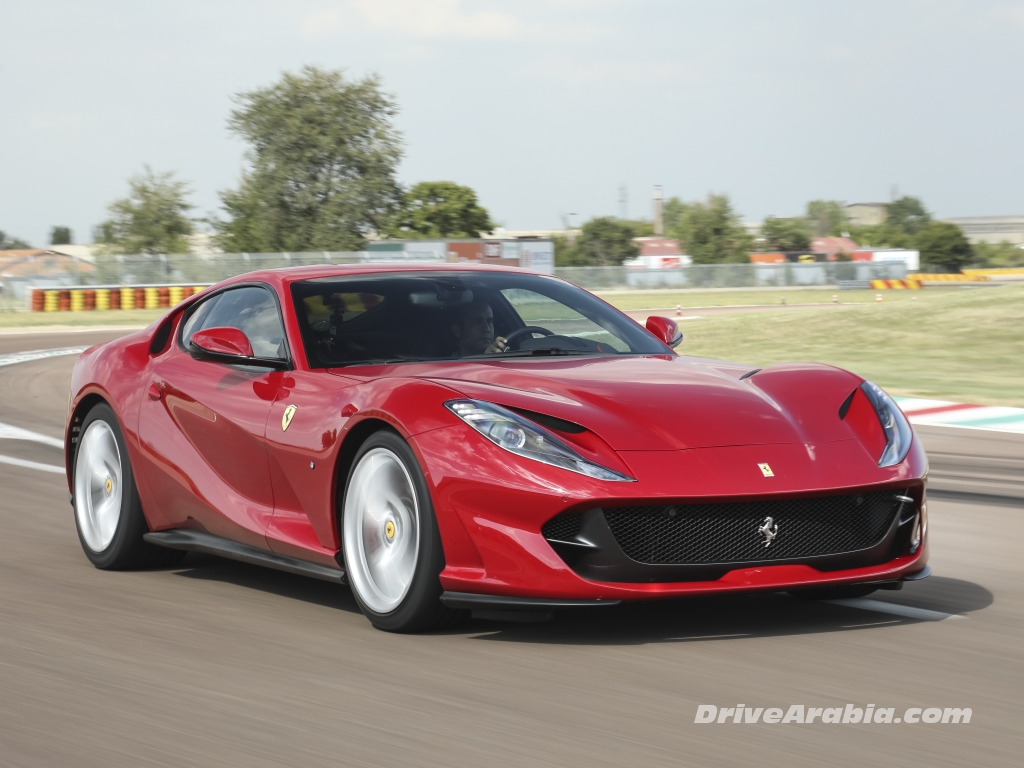
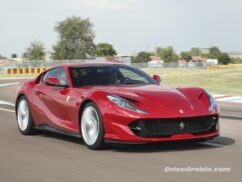
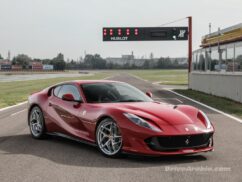
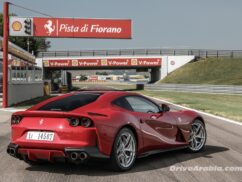
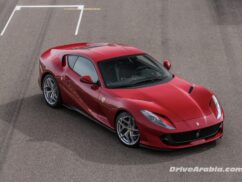

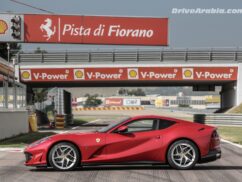








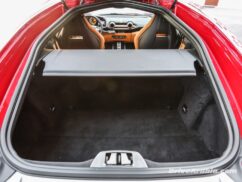
Comments
marc
boring design but driving-wise, this machine is right up there with the 720s of this world, if you believe jww 🙂
i like the darker red tone
Gautam Sharma
@marc: Comparing the 812 with a 720S is a little bit apples and oranges (hardcore mid-engined supercar vs front-engined GT). A 720S will undoubtedly be quicker on track (more than 200kg lighter, plus you can’t beat the performance gains that come with sticking the engine behind the cabin), but the 812 is BY FAR a more usable car — lovely, smooth drivetrain, supple ride, comfy cabin and very easy to get in and out of. You wouldn’t dream of driving the Mac everyday, but the 812 could easily serve as a daily driver. As for styling, always a subjective area, but wait until you see the Superfast in the metal. Looks far better in the flesh than it does in the pics…